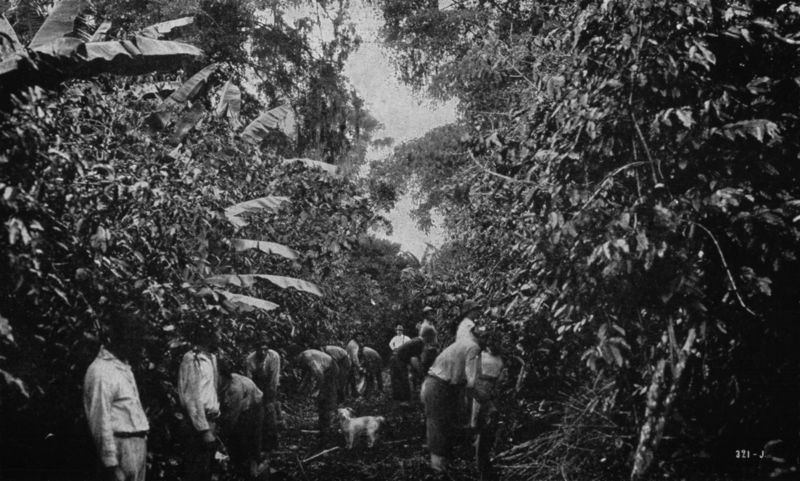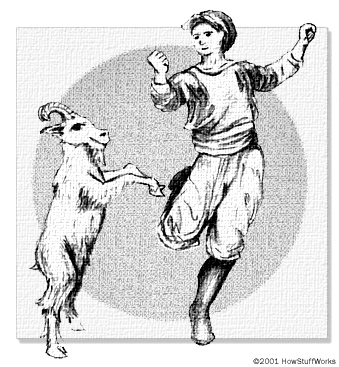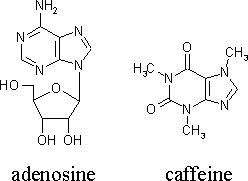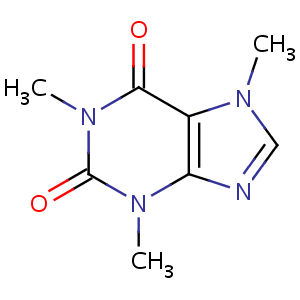Entries Tagged as 'Caffeine'
May 7th, 2008 · Comments Off on Coffee Industry Today
Introduction | What is Caffeine: Molecule Structure | Stimulating Science: The Properties of Caffeine | Discovery: The Magical Bean | Coffee Creates a Social Lifestyle in Europe |Colonization and Coffee|Coffee’s Impact on the Nation of Brazil|Coffee Industry Today| Conclusions
The beneficial effects of caffeine have created a world-wide demand for coffee throughout history. It has been integrated and transfixed in into modern society. The caffeine molecule has made coffee is the second most valuable commodity, after oil, in the world market. The coffee industry itself is a billion dollar industry, with revenue deriving from the growing of coffee, to packaging it and selling it, to coffee shops around the world.
One major example of a coffee shop which has taken full advantage of the current global demand for coffee is the American based Starbucks Corporation. The organization was founded in 1971 as a small coffee shop in Seattle, Washington and has grown to become an international corporation with over 15,000 locations in 44 different countries. Starbucks Corporation is extremely successful, with revenues have reached beyond $10 billion dollars (Yahoo Finance, 2008).
Companies like Starbucks echo the old coffeehouses of the 1600’s in Europe – for they are establishments where people can interact socially over a cup of coffee.

The global dominance of the coffee market has had other social implications as well. In recent years consumer consciousness and the relationship between the coffee growers and the coffee consumers have been in the spotlight. The poor treatment of workers on coffee plantations and the negative ecological repercussions of coffee cultivation have created a call for socially responsible and humane practices among coffee growing organizations. The demand for fairly traded coffee from the conscious consumer has increased greatly over the past decades. In All About Coffee, the fair trade movement is described as a “movement that focuses on paying producers fairly for the goods they produce, encouraging production techniques that promote environmental and social sustainability, and fostering long term, personal relationships among producers, traders and consumers”(Dicum & Luttinger, 1999, p 171). Companies within the industry have taken note, as well as taken action in this movement. For example, Starbucks is a supporter of fair trade and has a corporate social responsibility mission and vision statement which it follows.

[Read more →]
Categories: Caffeine
Introduction | What is Caffeine: Molecule Structure | Stimulating Science: The Properties of Caffeine generic cialis | Discovery: The Magical Bean | Coffee Creates a Social Lifestyle in Europe |Colonization and Coffee|Coffee’s Impact on the Nation of Brazil|Coffee Industry Today| Conclusions
Coffee had been imported solely from the Arab nations to Europe up until the eighteenth century. During the beginning of the 1700’s European powers – such as Britain, France and the Netherlands – began to colonize foreign lands. These countries decided to tap into the commercial market for coffee by establishing coffee plantations in many their colonies. Production of coffee occurred in colonies in Africa, South America as well as in the Caribbean.
The coffee industry proved to be a very lucrative one. Dicum and Luttinger discuss why this is when they write, “for most European colonial powers, coffee was a dream crop: a habit-forming, high value tropical product that travels well, with a ready market in Europe” (Dicum & Luttinger, 1999, p 26).
For these reasons, the coffee industry has remained an extremely profitable and successful market for centuries.
The introduction of coffee plantations and cultivation into European colonies would dictate the future of these nations. The majority of former colonies still continue to produce and export the coffee bean to countries around the world. The cultivation of coffee has had a major economic, social and political impact on these nations, by shaping their history as well as their future.

[Read more →]
Categories: Caffeine
May 7th, 2008 · Comments Off on Coffee’s Impact on the Nation of Brazil
Introduction | What is Caffeine: Molecule Structure | Stimulating Science: The Properties of Caffeine | Discovery: The Magical Bean | Coffee Creates a Social Lifestyle in Europe |Colonization and Coffee|Coffee’s Impact on the Nation of Brazil|Coffee Industry Today| Conclusions
One prime example of a former colony which the colonial cultivation of coffee has affected significantly is Brazil. The Portuguese introduced coffee to Brazil in 1732, and even after their independence in 1822, coffee would remain the Brazil’s dominate source of commercial revenue and largest agricultural crop. Author Robert Williams discusses the progression and the rise of the nation as a major coffee supplier in his book States and Social Evolution. He writes, “by the 1830’s, Brazilian production surpassed that of the older producing areas of the Dutch East Indies, and by 1881 more than half of world output came from Brazil… and by 1900 Brazil was producing more than two-thirds of the world’s coffee” (Williams, 1994, p 20). To this day, Brazil remains the leading coffee producing country in the world.
Coffee fueled the development and progression of the nation throughout the nineteenth and twentieth centuries. Many beneficial aspects arose from the cultivation of coffee. For example, networks of railways were built across the country. However, there were also social downsides; for instance, the abolition of slavery in the country was occurred very slowly. Slavery was not completely abolished until 1888, because many of the wealthy coffee growers relied on cheap labor on their plantations. Another negative effect was the disparities in wealth that were created within the social classes in Brazil.
The continual growth of coffee has also impacted the environment of the country. The landscape of Brazil has changed greatly due to the centuries of coffee cultivation. Large amounts of forests have been destroyed, which also eliminates much of the wildlife that would thrive naturally thrive in this environment. Le Couteur explains that, “grown as a monoculture, the coffee tree quickly exhausts soil fertility, requiring new land to be developed as the old becomes less and less productive” (Le Couteur & Burreson, 2003, p 267). This traps the nation in a vicious circle; and the constant clearing natural rainforest means that it will never be fully restored. Le Couteur also highlights the fact that the “overreliance on one crop generally means local populations forgo planting more traditional necessities, making them even more vulnerable to the vagaries of world markets” (Le Couteur & Burreson, 2003, p 268).
[Read more →]
Categories: Caffeine
Introduction | What is Caffeine: Molecule Structure | Stimulating Science: The Properties of Caffeine | Discovery: The Magical Bean | Coffee Creates a Social Lifestyle in Europe |Colonization and Coffee|Coffee’s Impact on the Nation of Brazil|Coffee Industry Today| Conclusions
By the early seventeenth century, the Ottoman Empire began to slowly crumble and European expansion of the time caused the ties between cialis online prescriptions the two areas to strengthen. As European travel to the Arab world increased, European merchants and traders soon fell under the spell of the exotic Arabic beverage known as coffee. It was at this time that Italian traders, who were based in Venice, brought coffee to Europe.
The coffee trade between Europeans and Arabic countries had begun.
As it had in Africa and the Middle East, the popularity of coffee spread quickly throughout Europe. Initially coffee was sold by vendors on the streets of Venice, but with its increased popularity, the first coffeehouses of Europe began to form. In 1650 the first coffeehouse was opened in Oxford, England. Other coffeehouses sprung up in cities such as Amsterdam, Marseilles, and Paris. And by 1715, around 2,000 coffeehouses existed in London alone. Images of London coffeehouses can be seen below.


Coffeehouses were seen as social clubs, where people would gather to sit and sip coffee while conversing for hours. Open to members of different social classes, coffeehouses were unique locations. As Dicum notes, the coffeehouses were “crowed with people from all walks of life discussing politics and cultural matters, coffeehouses become centers for urban social life” (Dicum &Luttinger, 1999, p 13).
As coffeehouses aided in defining social life in Europe, they were simultaneously creating a new market in the economy. The powerful nations of Europe realized they could stand to gain from the ever increasing demand for the coffee bean.
[Read more →]
Categories: Caffeine
April 23rd, 2008 · Comments Off on Conclusions
Introduction | What is Caffeine: Molecule Structure | Stimulating Science: The Properties of Caffeine | Discovery: The Magical Bean | Coffee Creates a Social Lifestyle in Europe |Colonization and Coffee|Coffee’s Impact on the Nation of Brazil|Coffee Industry Today| Conclusions
The caffeine molecule has had a profound effect on the history of our world. The drug that has beneficial and stimulating properties has been a staple in society over the centuries. Caffeine, in the form of coffee, has continuously impacted social, economical, and political thoughts and actions. From the first uses of coffee in the Arabic world, to the coffeehouses of Europe, to colonization, to the development of countries such as Brazil, to today where the coffee industry is one of the most large and powerful markets in the world – caffeine has never ceased to influence history. Caffeine, and coffee, will continue to effect and shape the future of the world in the centuries to come.
[Read more →]
Categories: Caffeine
Introduction | What is Caffeine: Molecule Structure | Stimulating Science: The Properties of Caffeine | Discovery: The Magical Bean | Coffee Creates a Social Lifestyle in Europe |Colonization and Coffee|Coffee’s Impact on the Nation of Brazil|Coffee Industry Today| Conclusions
There is no doubt that human beings have consistently consumed caffeine since the Stone Age. It is hypothesized that ancient people discovered that chewing on certain plants had stimulating effects on the body and mind. Myths of the initial discovery of the coffee bean and its properties vary from culture to culture. Coffee is indigenous to Ethiopia, therefore it comes as no surprise that one well known legend comes from this nation. The Ethiopian myth describes the story of a goatherd named Kaldi, whose goats nibbled on a bush covered in red berries. After the goats had consumed the berries, they became frisky and started to dance on their hind legs. Kaldi was intrigued by the strange actions of his goats and decided to try the berries for himself. After tasting the magical berries he too became energized and started to dance with his goats. A local monk noticed the goatherd’s behavior, and came to the realization that the invigorating effects of this bean could help monks remain alert and awake during long religious sessions of prayer. It was then that the monk brewed the first cup of coffee.

The consumption of coffee spread across northern Africa, and then into Arabia. And by the sixteenth century, coffee had become a staple throughout the Arab world. So much so that in countries such as Turkey the drink was considered to be as important as bread or water. The popularity of coffee can not only be contributed to the beneficial effects of the caffeine, but also to the religious ties in the Middle East to Islam. Islamic law prohibits the consumption of alcohol; therefore coffee provided a substitute. As the popularity of the beverage increased, the western world began to take notice.
[Read more →]
Categories: Caffeine
Introduction | What is Caffeine: Molecule Structure | Stimulating Science: The Properties of Caffeine | Discovery: The Magical Bean | Coffee Creates a Social Lifestyle in Europe |Colonization and Coffee|Coffee’s Impact on the Nation of Brazil|Coffee Industry Today| Conclusions
Caffeine is a psychoactive drug that is believed to be one of the most commonly used drugs around the world. After one ingests caffeine, it enters the bloodstream within ten minutes, and remains in one’s body for around twelve hours. “Caffeine has powerful psychological effects on humans and animals. It stimulates heart muscles and relaxes certain structures that contain smooth muscle, including the coronary arteries and bronchi. It is also a diuretic” (Smith, 2004, p 153).
It is also a central nervous system stimulant. Caffeine blocks the effect of the molecule adenosine in the brain, as well as in other areas of the body. Adenosine, as described in Napoleon’s Button’s is “a neuromodulator, a molecule that decreases the rate of spontaneous nerve firing and thus slows the release of other neurotransmitters; therefore can induce sleep” (Le Couteur & Burreson, 2003, p 261). Caffeine interferes with this process by binding to the adenosine receptors in the nerves, and therefore, the effects of adenosine that render one tired or sleepy cannot take place. Adenosine receptors are not only located in the brain, and can be found in other parts of the body. When caffeine molecules occupy these receptors, one will experience a “caffeine buzz” – which consists of increased heart rate, and the constriction or opening of blood vessels. (Le Couteur, 2003, p 261). One can observe below the similarities of the structures of adenosine and caffeine.

[Read more →]
Categories: Caffeine
Introduction | What is Caffeine: Molecule Structure | Stimulating Science: The Properties of Caffeine | Discovery: The Magical Bean | Coffee Creates a Social Lifestyle in Europe |Colonization and Coffee|Coffee’s Impact on the Nation of Brazil|Coffee Industry Today| Conclusions
Caffeine is a naturally occurring molecule that can be found in over sixty different plants. The caffeine acts as a natural pesticide, and protects the plants by paralyzing or killing insects that attempt to feed on the plant. The most widely used caffeine containing plants are coffee, tea. The caffeine molecule is classified as an alkaloid, meaning that it is a nitrogen-based compound that is extracted from plants. The chemical formula for caffeine is C8H10N4O2, is found in coffee.

Caffeine, in its pure form, is found as odorless bitter white crystals. Pure caffeine is very soluble in hot water, which is why drinks like coffee and tea contain high amounts of caffeine. The melting point is 238° C (460° F). On average, a cup of coffee contains around 100 mg of caffeine. In contrast, the average cup of tea contains around 40 mg and the same amount can be found in a 12-ounce cola beverage.
caffeine3.txt
[Read more →]
Categories: Caffeine
Introduction | What is Caffeine: Molecule Structure | Stimulating Science: The Properties of Caffeine | Discovery: The Magical Bean | Coffee Creates a Social Lifestyle in Europe |Colonization and Coffee|Coffee’s Impact on the Nation of Brazil|Coffee Industry Today| Conclusions

Caffeine is one of the most widely consumed molecules in the world, and has been for centuries. It has remained popular because of its many positive effects on the body, which include stimulating the central nervous system, and making one more alert and giving one a boost of energy. About 90% of Americans consume caffeine every single day, and it has been estimated that over 120,000 tons of caffeine is consumed around the global per year. This makes caffeine America’s most popular drug by far. Caffeine is most commonly consumed in the form of coffee, tea, or chocolate. Although caffeine in the form of tea or chocolate have both impacted the history of the world significantly, this paper will focus on the major effects coffee has had on society and how the beverage has shaped many aspects of our collective history. Coffee has impacted the world socially, economically and politically over the centuries, influencing trading, colonization, and the development of countries as well as new industries.
[Read more →]
Categories: Caffeine









